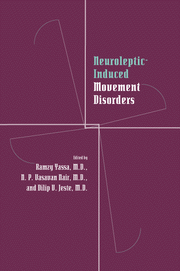Book contents
- Frontmatter
- Contents
- Contributors
- Preface
- Part I Historical perspective
- Part II Clinical aspects of tardive dyskinesia
- Part III Mechanisms underlying tardive dyskinesia
- Part IV Measurement of tardive dyskinesia
- Part V Tardive dyskinesia in different populations
- Part VI Other neuroleptic-induced movement disorders
- Part VII Treatment of tardive dyskinesia
- Index
Preface
Published online by Cambridge University Press: 09 October 2009
- Frontmatter
- Contents
- Contributors
- Preface
- Part I Historical perspective
- Part II Clinical aspects of tardive dyskinesia
- Part III Mechanisms underlying tardive dyskinesia
- Part IV Measurement of tardive dyskinesia
- Part V Tardive dyskinesia in different populations
- Part VI Other neuroleptic-induced movement disorders
- Part VII Treatment of tardive dyskinesia
- Index
Summary
It is interesting to note that the three classes of psychotropic drugs that were introduced into psychiatry within the span of a few years around 1950 have had greater impact in the treatment of the major psychiatric disorders than have any other forms of treatment in this century. These include the antipsychotic drugs or neuroleptics, the tricyclic antidepressants, and lithium. Of the three groups, neuroleptics are easily the most widely prescribed agents worldwide. They are being used – and sometimes overused and misused – to treat not only schizophrenia and other psychoses but also a host of additional behavioral disorders. Although neuroleptics continue to be indispensable in the management of a majority of schizophrenic patients, as well as some other psychotic individuals, they have not proved to be an unmixed blessing. In terms of frequency, persistence, and overall impact on the quality of wellbeing for patients and caregivers, movement disorders are the most serious adverse side effects of neuroleptics.
The importance of iatrogenic movement disorders in psychiatry can be deduced from the fact that the Diagnostic and Statistical Manual of Mental Disorders, fourth edition (DSM-IV), recently published by the American Psychiatric Association, includes a separate category of “medication-induced movement disorders.” This newly delineated group of conditions primarily includes neuroleptic-induced movement disorders such as parkinsonism, dystonia, akathisia, and, especially, tardive dyskinesia. The American Psychiatric Association had previously appointed two task forces on tardive dyskinesia, and those groups published reports in 1980 and 1992.
- Type
- Chapter
- Information
- Neuroleptic-induced Movement DisordersA Comprehensive Survey, pp. xv - xviiiPublisher: Cambridge University PressPrint publication year: 1996

